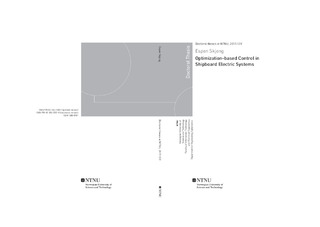| dc.description.abstract | With stringent, and globally sanctioned, environmental rules and regulations, dictating limits for allowed emissions of greenhouse gases and particle matter from combustion of fossil fuels, the marine vessel’s efficiency has recently received a lot of attention. At the same time, in addition to meet environmental requirements from multiple stakeholders, ship owners strive to enhance revenue in an economically challenged market by reducing operational costs and gain competitive advantages. Examples of such competitive advantages are reduced environmental footprints, increased vessel/operational platform efficiency, operational flexibility and reliability, and higher Environmental Regularity Numbers (ERN). To asses the marine vessel’s efficiency is complex and involves multiple disciplines. In this work, the main contributions are centered around the discipline automation and automatic control design, with the use of optimization-based control strategies to improve the (AC) shipboard power plant’s efficiency. Two topics are covered in this thesis: Optimal harmonic mitigation using Model Predictive Control (MPC), and optimization-based unit commitment as part of Energy Management Systems (EMS). These two topics, although intertwined, represents different levels of power system control and contribute both to the efficiency of the shipboard power plant.
The thesis is divided into three parts. The first part, which is covered by Chapter 2, presents a review of the shipboard electrical power system’s evolution. From the first successful use of shipboard electricity, marked by the use of electricity in SS Columbia in 1880 for illumination purposes, to present day with all-electric vessels using batteries, the shipboard power system has transitioned from containing few single-purpose passive components to containing many multi-purpose active components that rely on automatic control. Thus, the discipline automation and automatic control design plays an important part in the present stage of the shipboard electrical power system’s evolution. Chapter 2 ends with a discussion of properties and challenges of the marine vessel’s power system, including, among others, AC vs DC, integrated power systems and grid design, power electronics, harmonic pollution and electrical stability, and the increasing level of software complexity.
The second part of the thesis, which is covered by Chapter 3-5, addresses the problem of harmonic pollution and presents a novel harmonic mitigation strategy based on optimal control. The proposed method, which relies on a single, controllable Active Power Filter (APF), uses an MPC that (online) generates APF current references based on an optimization objective to minimize the total harmonic pollution in the whole power system – a system-level harmonic mitigation approach. Chapter 3 presents simulation results of the proposed method compared with two conventional APF control strategies using a two-bus shipboard power system with 6- and 12- pulse rectifier loads as test subject. The results demonstrate that the MPC is able to generate current references that better utilize the APF current capability for system-level harmonic mitigation, and is able to reduce the Total Harmonic Distortion (THD) beyond what is achieved with the conventional mitigation approaches. Chapter 4 introduces a system-level harmonic mitigation approach, also considering the control of a single APF, that is based on offline analytical optimization. The offline analytical optimization method is compared with the MPC in Chapter 3 and conventional mitigation strategies using a two-bus shipboard power system with 12-pulse rectifier loads as test subject. Non-idealities, such as parameter-mismatch and transformer saturation, are introduced in the simulation, and the results show that also in this case the MPC-based system-level harmonic mitigation method is superior compared to the offline analytical optimization and the conventional mitigation approaches. The last chapter in this part, Chapter 5, addresses an event-based system architecture with real-time implementation of a single-phase version of the MPC presented in Chapter 3 and 4 for system-level harmonic mitigation. Hardware-In-Loop (HIL) simulations using two desktop computers and a simulator demonstrate that the proposed system architecture and MPC implementation meet the real-time requirements for system-level harmonic mitigation.
The last part of the thesis, which is covered by Chapter 6, addresses the problem of unit commitment in an Energy Management System (EMS). Real power system data from three different vessels in operation, a ferry, a Platform Supply Vessel (PSV) and a seismic survey vessel, are extracted and analyzed with regards to diesel-generator-set (genset) loadings and genset running hours to shed light on potential fuel efficiency improvements. As demonstrated by the extracted data, the gensets in all three vessels run with non-optimal loading conditions relative individual gensets’ Specific Fuel Oil Consumption (SFOC) curves. Two unit commitment methods, one based on Mixed-Integer Linear Programming (optimization) and one based on logics, are presented and discussed. Moreover, three power system configurations are proposed; i) four fixed-speed gensets, ii) three fixed-speed genset and one variable-speed genset, and iii) four fixed-speed gensets and an Energy Storage System (ESS). The two unit commitment methods are compared by simulation studies of the three proposed power system configurations, using the real load profiles extracted from the three vessels during operation. The simulation results indicate that optimal EMS algorithms in combination with a revised power system configuration can increase the operational efficiency, in terms of fuel savings and reduction in genset running hours. The last chapter in the thesis, Chapter 7, summarizes and concludes the work, and presents recommendations for future work. | nb_NO |
